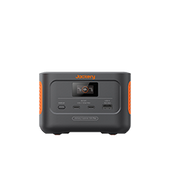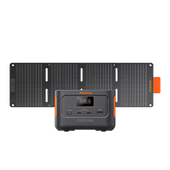Dispersed Camping 101: What Is, Pros & Cons, Gear, Tips
There are numerous reasons to explore dispersed camping or sleeping in an undesignated campground. You'd prefer to put your self-sufficiency to the test outside, away from cell coverage and amenities like running water. You should feel more connected to nature by camping away from crowds.
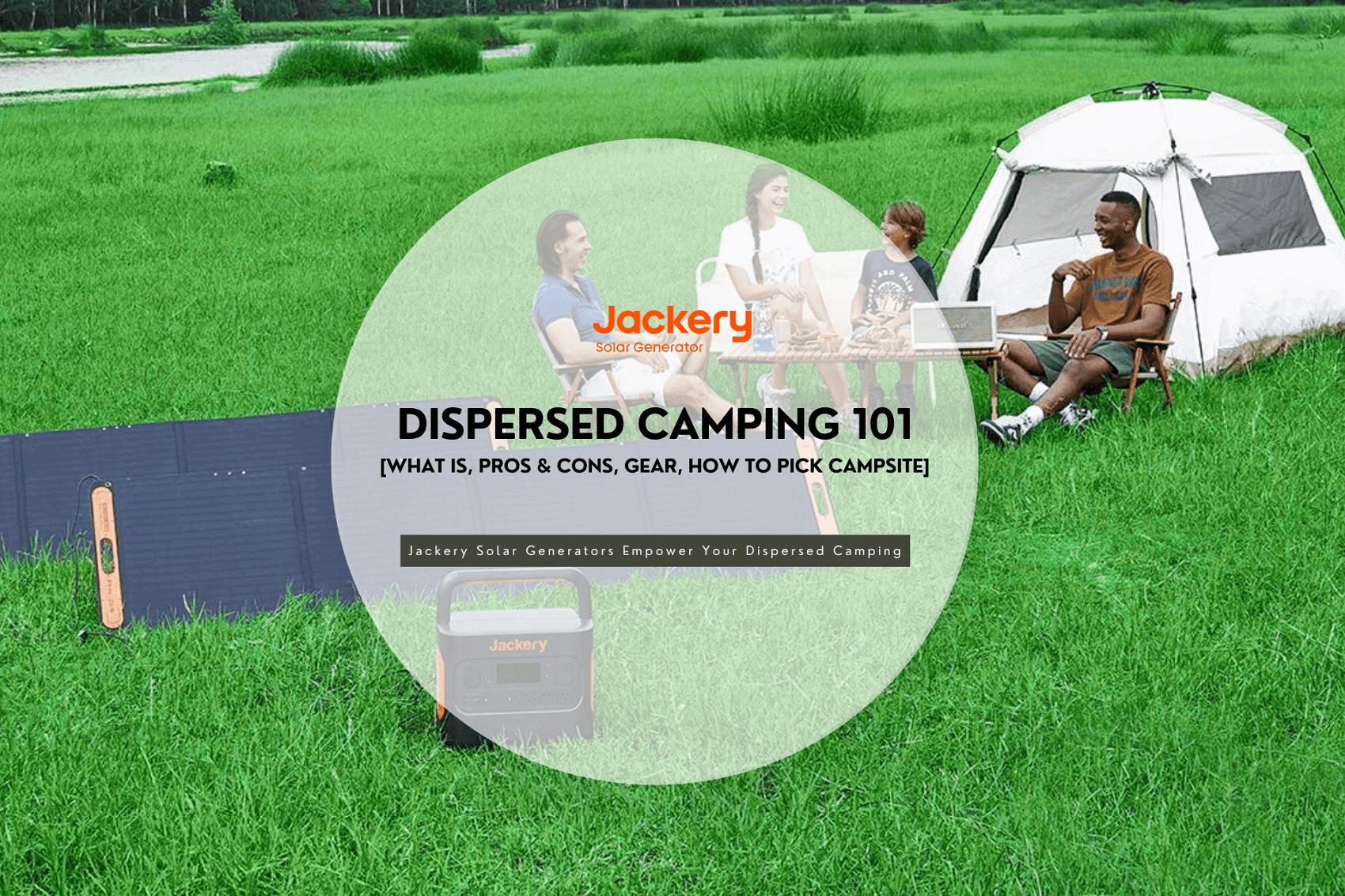
Whatever your reason, dispersed camping can be a fun way to broaden your camping options and acquire new outdoor skills. But, before you go out for an unplugged night, you should know a few things, such as what gear and skills you'll need and how to be a good custodian of the wild locations you visit.
From this page, you will learn everything about dispersed camping, including what it is, how it differs from designated camping or boondocking, its pros and cons, gear, and how to find the best campsites. The most important thing is to take a Jackery Solar Generator to power all your camping appliances in case of emergencies.
|
Products |
Images |
Capacity |
Rated / Peak Power |
Size |
Weight |
|
Solar Generator 2000 Pro |
 |
2160Wh |
2200W Rated, 4400W Peak |
15.1x10.5x12.1in |
43 lbs |
|
Solar Generator 1000 Pro |
 |
1002Wh |
1000W Rated, 22000W Peak |
13.39x10.32x10.06in |
22 lbs |
|
Solar Generator 500 |
 |
518Wh |
500W Rated, 1000W Peak |
11.8x7.6x9.2in |
13.32 lbs |
What Is Dispersed Camping?
When defining dispersed camping, starting with what it isn't is useful. It is optional to have conveniences when camping in a remote location. It does not require a camp host or reservations, and you are unlikely to encounter other campers.
Many campers yearn for the solitude and authentic experience that can only be found far from civilization and crowded campgrounds. Camping anyplace in the National Forest outside a recognized campground is called dispersed camping.
Dispersed camping means no services, such as trash collection, and few or no facilities, such as fire pits, tables, and electricity. Some of the most frequented dispersed camping spots may have facilities like restrooms. At that point, a solar generator, such as the Jackery Solar Generator, appears significantly more critical in powering your camping gadgets.
Dispersed camping necessitates additional obligations and abilities. You should be aware of these before embarking on this new adventure. Camping restrictions and regulations apply to ensure your safety and the preservation of natural resources for future campers.
Designated Camping VS. Dispersed Camping
If you've ever camped at a well-known campsite, chances are it was a designated camping area. These developed areas often include marked campsites and access to electricity hookups, drinkable water, Wi-Fi, or toilets. A national park or forest service typically manages them. Most require a fee and a reservation to use.
Anything outside of a built, designated campsite is considered dispersed camping. It's not wilderness camping but more primitive than a selected location with tent platforms or electricity hookups. Unlike authorized sites, dispersed locations often lack running water and restrooms. However, well-trafficked regions may include the occasional vault toilet.
Boondocking VS. Dispersed Camping
Boondocking is camping in distant locations with no access to utilities. However, boondocking is possible anywhere, including BLM (Bureau of Land Management) and other public areas.
Camping (typically without amenities) in a national forest is known as dispersed camping. Unless you're at a dispersed campground, most campers in a national forest are also boondocking. If you live in one, you may or may not have utilities, but you must park in a designated and numbered space.
Primitive Camping VS. Dispersed Camping
Backcountry camping in isolated places without amenities such as bathrooms, picnic tables, garbage cans, or other manufactured structures is known as primitive camping. Although dispersed and primitive camping are frequently used interchangeably, primitive campers typically leave the car at home in favor of hiking, biking, or another non-gas-powered form of movement. Both types of camping provide similar benefits, but one is accessible by car (four-wheel drive is advised), while the other demands a little more work.
What Are The Pros & Cons of Dispersed Camping?
Dispersed camping may be a powerful and even rejuvenating experience for the mind, body, and soul. However, obtaining the necessary skills and preparedness for dispersed camping requires time, research, and trial and error. The following are the benefits and drawbacks of dispersed camping:
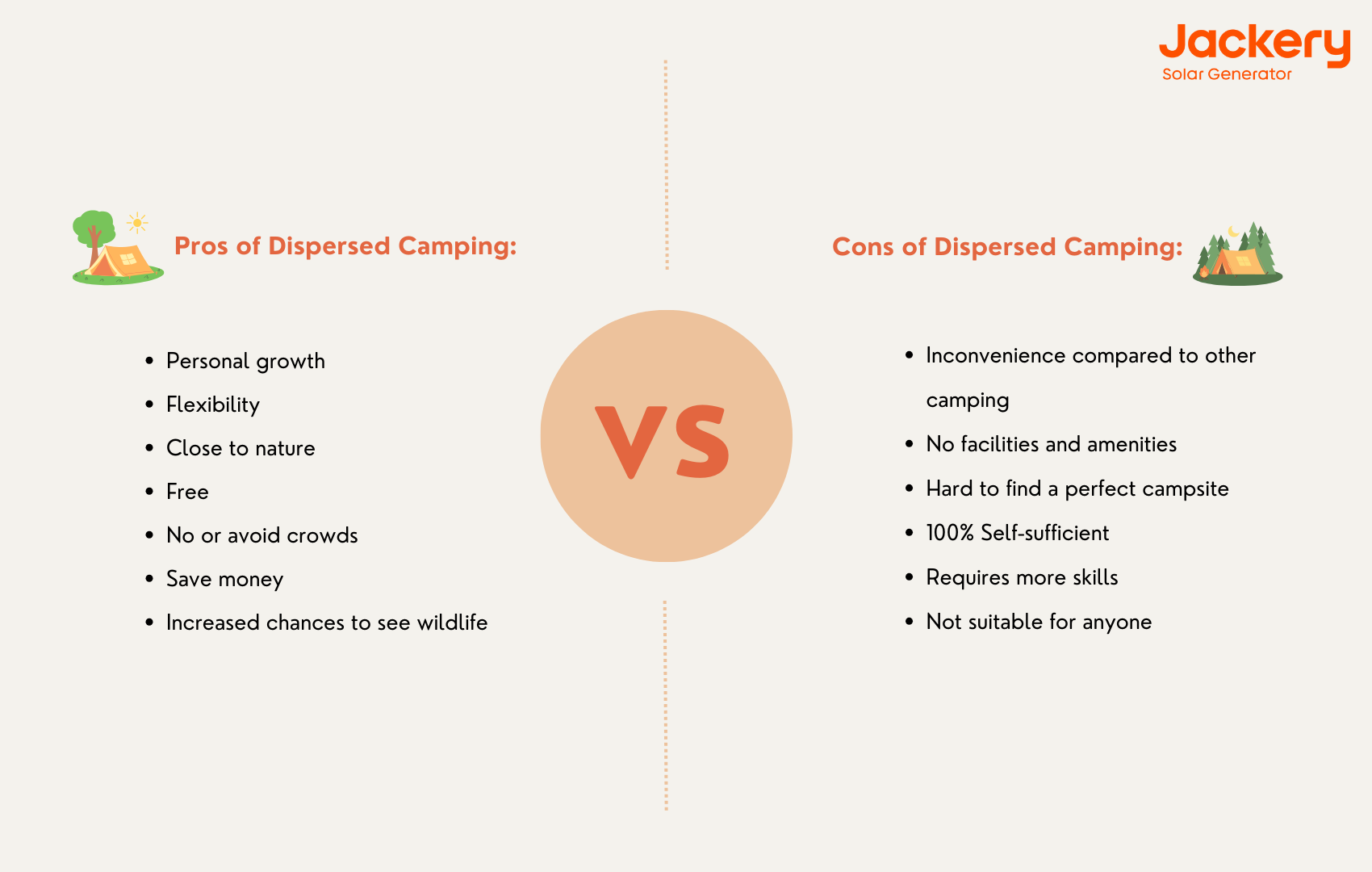
The Pros of Dispersed Camping
Dispersed camping has a lot to offer. There is no better way to unplug. These places need electricity and are unlikely to get mobile service. Furthermore, people seeking solitude are likelier to find it at a dispersed campsite, as it requires a little more work than simply rolling into an established place.
Camper lovers with flexible itineraries or who love unexpected experiences can arrange plans on the fly because most dispersed sites do not require reservations. In most situations, claiming a place is free—though some state and national parks may charge an admission or car fee or a leisure pass.
You can also select from various dispersed campsites based on your comfort and ability level. For those new to dispersed camping who wish to progressively improve their skills, choosing a roadside dispersed campground may feel more approachable than one in the bush because you can access your vehicle if necessary.
The Cons of Dispersed Camping
Of course, dispersed camping has drawbacks, many of which are logistical. You'll need to do more preparation, which takes time and research because you'll need to prepare for more variables than you would while camping at a defined spot—location of water sources, where you want to go to the bathroom, how you'll dispose of your rubbish.
Early planning is crucial for campers with disabilities to have a successful night outside. Although dispersed camping may be less accessible than sites at official campgrounds, many of which must be ADA-compliant by law, it is not impossible.
Dispersed camping also necessitates specific abilities, such as safely purifying water and pooping and assessing the topography to select the optimum tent location. You'll also need more equipment than you would at a campground.
Furthermore, you should not expect cell reception and should have an emergency plan. Sometimes, a personal locating beacon or satellite communication device may be appropriate. These gadgets communicate by connecting to satellite networks.
Dispersed Camping Packing List: What to Bring?
Generally, you will need everything you usually carry for camping at a conventional campground. If you're backpacking, you may need a larger pack and only bring the necessities.
The most crucial consideration in dispersed camping is how much water to bring. One to two gallons of water per person each day is a good starting point. You can pack less if camping near a water source, such as a spring or stream.
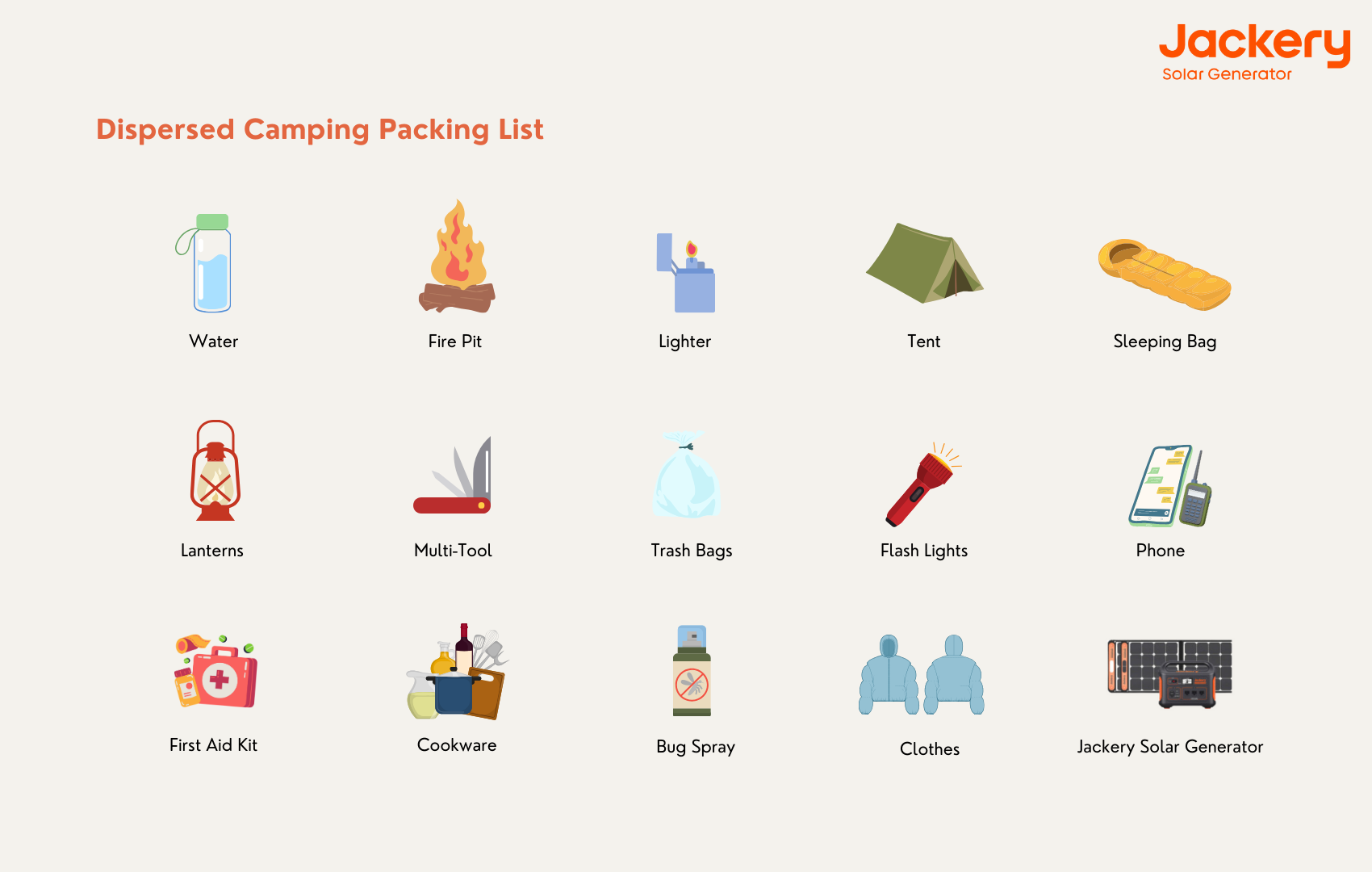
If camping in a wildfire-prone location, you may need to bring additional equipment, such as a shovel and an ax. Bring a trash bag to pack any rubbish you bring in or find conveniently. The dispersed camping packing list that you might refer to for your journey is as follows:
|
Dispersed Camping Packing List |
||
|
Water |
Water Bottle |
Kettle |
|
Fire Pit |
Lighter |
Tent |
|
Sleeping Bag |
Multi-Tool |
Shovel |
|
Ax |
Trash Bag |
Flash Lights |
|
Phone |
Satellite Phone |
Radio |
|
Bug Spray |
Cookware |
First Aid Kit |
|
Layers |
Water-Proof Coat |
Water-Proof Boots |
|
Foods |
Paper Towels |
Jackery Solar Generator |
Whether or not you use your phone for navigation, bring a portable solar generator and its associated cords. If you're going farther into the wilderness, consider purchasing a satellite phone or personal locating beacon. They genuinely save lives.
Get a solar-powered portable generator to power your essentials. Solar generators outperform gas-powered generators because of their low operational expenses and infinite power sources. This portable power supply can charge your phone and your lights, satellite phone, navigation, portable oven, and other devices.
The Jackery Solar Generators are easy to use, even for individuals who have never used one. All that remains after configuration is to turn it on and connect your devices. Dispersed camping is typically associated with unplugging technology and enjoying nature. While this is correct, many people would benefit from having a solar generator in an emergency.
The majority of your outdoor appliances can be charged with Jackery Solar Generators. Furthermore, because of their lightweight and easy-to-carry design, they may be taken anywhere. You will always be happy with bringing a solar generator on your camping trip.
Jackery Solar Generators for Dispersed Camping
This one is for all of our environmentally aware readers! Solar generators derive power from the sun, providing customers with clean, sustainable energy. This ensures you'll never be exposed to odors while dispersed camping! Jackery Solar Generators use clean energy and are completely safe for charging your appliances outside.

Jackery Solar Generators, the best-dispersed camping solar generators, combine Jackery Solar Panels and Portable Power Stations to transform sunshine into electricity, which can then power outdoor items like an outdoor shower, camping lighting, outdoor oven, and so on.
Monocrystalline silicon solar cells allow for more effective sunlight absorption and conversion rates. The Jackery Portable power station has a pure sine wave inverter and an MPPT (Maximum Power Point Tracking) charge controller to ensure a continuous and uninterrupted electricity supply.
Furthermore, Explorer Portable Power Stations offer a pass-through function that simultaneously charges the power station and outdoor appliances.
Jackery Solar Generator 2000 Pro
The Jackery Solar Generator 2000 Pro combines the Explorer 2000 Pro Portable Power Station with two SolarSaga 200W solar panels that turn sunlight into power—with a massive charge capacity of 2,160Wh, powering most outdoor gadgets while camping is simple. It can, for example, power a 400W compact fridge for 4.3 hours or a 25W camping light for 69.1 hours. With the sun's immense vitality, go to the world's most stunning locations, take a road trip, discover the great outdoors, and enjoy life to the fullest with friends.

The Solar Generator 2000 Pro uses 100% clean and infinite solar energy with a sophisticated MPPT controller for your dispersed camping. The Explorer 2000 Pro portable power station can be fully charged in 7.5 hours using 2* Jackery SolarSaga 200W solar panels or in 2 hours using an AC wall outlet. In less than 2.5 hours, 6* SolarSaga 200W solar panels fully charged the battery.
The handle's ergonomic design facilitates a comfortable grasp. Enjoy excellent charging efficiency with one touch, simple and quick setup in 60 seconds. The Explorer 2000 Pro portable power station produces less than 53dB of power, ensuring quiet while charging.
|
Product |
Solar Generator 2000 Pro |
|
Capacity |
2160Wh |
|
Life Cycles |
1000 cycles to 80%+ capacity |
|
Dimensions |
15.1 x 10.5 x 12.1in (43lbs) |
|
Using Temperature |
14-104F (-10-40℃) |
|
Recharging |
Solar Charging (6*SolarSaga 200W): 2.5H AC Adapter: 2H 12V Car Adapter: 24H |
|
Output Ports |
3*AC Output: 120V, 60Hz, 2,200W (4,400W Peak); 3*USB-A: Quick Charge 3.0, 18W Max; 3*USB-C: 100W Max, (5V, 9V, 12V, 15V, 20V up to 5A); 1*Carport: 12V⎓10A |
|
Working Hours |
Small Fridge(400W): 4.3H Camping Lighting(25W): 69.1H Outdoor Fan(30-60W): 28.8-57.6H Outdoor Grill(1000-1500W): 1.2-1.7H Camera(44W): 39.3H Phone(2-6W): 288-864H |
Jackery Solar Generator 1000 Pro
The Jackery Solar Generator 1000 Pro is a solar system that combines SolarSaga 100W or 200W solar panels with the Jackery Explorer 1000 Pro portable power station, which is a highly silent solar generator with a 10-year lifespan and can be fully charged in 1.8 hours. Its double 100W PD design provides consistent power, charging all essential gadgets while dispersed camping.

The Explorer 1000 Pro takes 1.8 hours to charge from a power outlet or 4*200W solar panels with an AC input of up to 800W. The Explorer 1000 Pro has a foldable handle for more accessible transport. Make room for any on-the-go travel. Furthermore, its revolutionary bright screen displays 18 operating modes with crystal clear sight.
The pure sine wave inverter provides consistent power with minimal noise (46dB), preventing harm to your equipment. The product produces almost no noise and includes a battery management system (BMS) for extended battery life. The flexible LED light is designed to meet your outdoor lighting requirements. It can power your 60W outdoor fan for 13.4 hours and your 44W camera for 18.2 hours.
|
Product |
Solar Generator 1000 Pro |
|
Capacity |
1002Wh |
|
Life Cycles |
1000 cycles to 80%+ capacity |
|
Dimensions |
13.39x10.32x10.06in (25.4lbs) |
|
Using Temperature |
14-104F (-10-40℃) |
|
Recharging |
Solar Charging (4*SolarSaga 200W): 1.8H AC Adapter: 1.8H 12V Car Adapter: 12H |
|
Output Ports |
3*AC Output: 120V, 60Hz, 1000W (2000W Peak); 2*USB-A: Quick Charge 3.0x2, 18W Max; 2*USB-C: 100W Max, (5V, 9V, 12V, 15V, 20V up to 5A); 1*Carport: 12V⎓10A |
|
Working Hours |
Small Fridge(400W): 2H Camping Lighting(25W): 32.1H Outdoor Fan(30-60W): 13.4-26.7H Outdoor Grill(1000): 0.8H Camera(44W): 18.2H Phone(2-6W): 133.6-400.8H |
Jackery Solar Generator 500
The Explorer 500 Portable Power Station and the SolarSaga 100W solar panels are combined to form the Solar Generator 500. With a capacity of 518Wh, this power source can run a variety of dispersed camping gear such as a mini cooler, satellite phone, fan, and more.
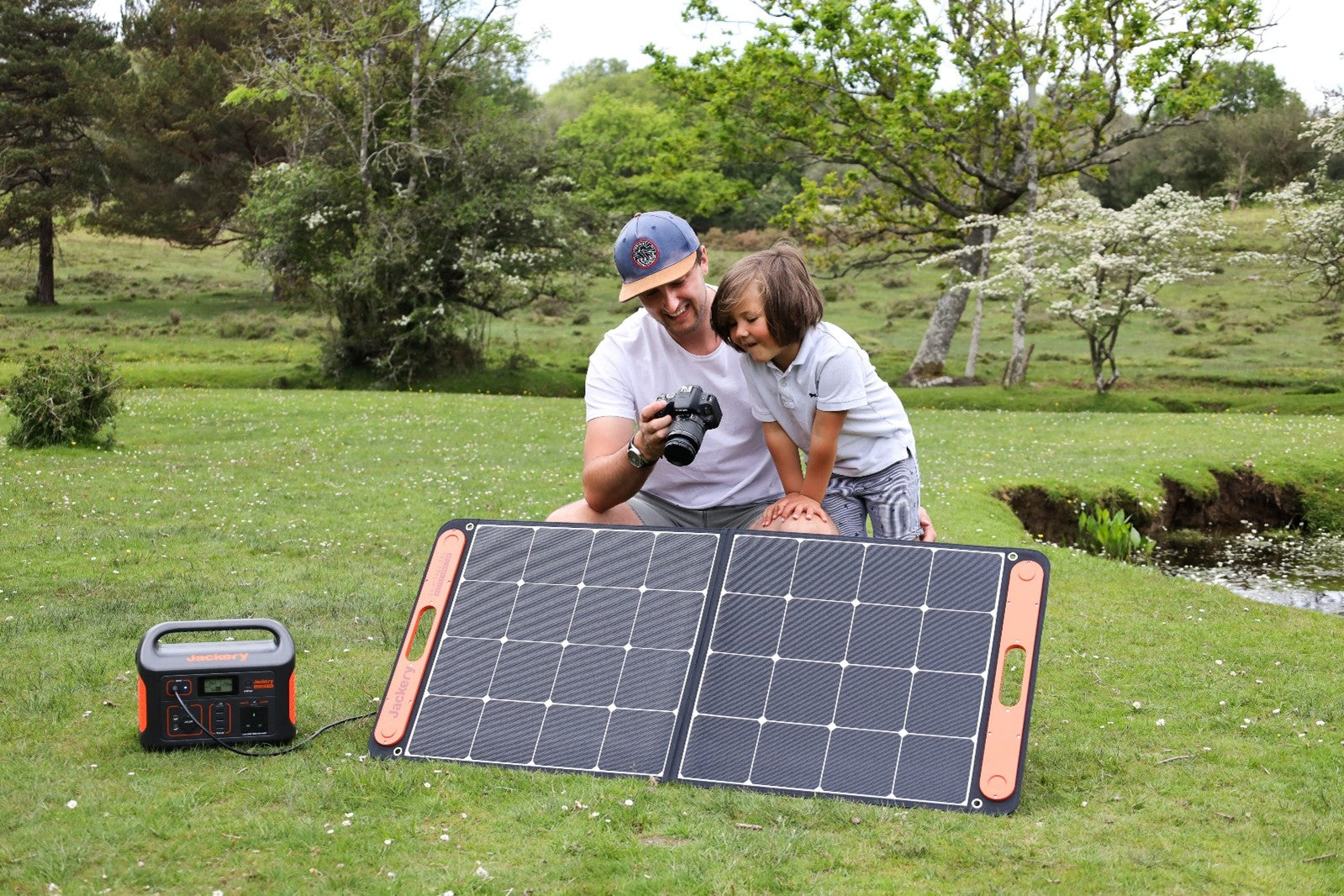
The Jackery Solar Generator 500 has three USB connections, an AC outlet, and a 12V carport output. It has a PURE SINE WAVE inverter and an MPPT regulator to provide smooth and constant electricity by converting solar energy, and it can charge a variety of standard electronics and small appliances. For example, the Solar Generator 500 can power a 44W camera for 9.4 hours or a 30W portable fan for 13.8 hours.
The Explorer 500 portable power station is equipped with a lithium-ion battery pack. It has a meticulously constructed frame structure that optimizes power output and assures durability for extended outdoor use. The Explorer 500 is the size of a conventional basketball and is incredibly portable due to its firm grip. As a result, it is a compact and dependable solution for dispersed camping.
|
Product |
Solar Generator 500 |
|
Capacity |
518Wh |
|
Life Cycles |
500 cycles to 80%+ capacity |
|
Dimensions |
11.8x7.6x9.2in (13.32lbs) |
|
Using Temperature |
14-104F (-10-40℃) |
|
Recharging |
Solar Charging: 9.5H AC Adapter: 7.5H 12V Car Adapter: 7.5H |
|
Output Ports |
1*AC Output: 110VAC, 60Hz, 500W (1000W Surge); 2*DC Output: 12V, 7A; 3*USB-A: 5V, 2.4A; 1*Carport: 12V⎓10A |
|
Working Hours |
Small Fridge(400W): 1H Camping Lighting(25W): 16.6H Outdoor Fan(30-60W): 6.9-13.8H Camera(44W): 9.4H Phone(2-6W): 69.1-207.2H |
How to Find The Best Dispersed Campsites?
A self-sustaining night in nature is worthwhile if you put in the extra effort. Here's how to set up camp in a location that works for you and the environment.
Dispersed camping grounds are not all created equal. The question isn't always "Can I camp here?" but "Should I camp here?" Some sites where you can camp may be unpleasant if they are not ideal for how you prefer to camp. Follow these steps to make it easier to discover a dispersed camping site:
Step 1: Find A Site
Finding a campsite is the first step after opting to camp. Most national forest or BLM land websites will have dispersed camping maps. If you need help finding the information you need online, contact ahead or go to the Ranger District office in person.
Dispersed campsites are typically available on a first-come, first-served basis, though this varies depending on the property manager. Visitors must register rudimentary "motorized, roadside campsites" in Pennsylvania state forests and pay a $10 per-night fee. It is true even if the campsite is only a short distance from the car.
Step 2: Select A Place
It's time to look for your home away from home. Before dispersed camping, familiarize yourself with the Leave No Trace Seven Principles. These best practices assist in conserving natural environments by addressing anything from reducing fire impacts to appropriately disposing of rubbish.
Whether you want to camp on the road or the path, try to find a used overnight area. That is, look for a site where someone has already tented. Look for vehicle tire marks, prepare fire rings, and clear spaces cleared for tents to tell.
Step 3: Evaluate The Surroundings
So you've discovered what appears to be a flat, forested land that adheres to Leave No Trace principles. Before you pitch your tent, take a look around you. Is there enough canopy cover to keep your tent from scorching in the sun?
Are there any dead or dying trees or damaged branches that could fall overnight? Is there any new evidence of scat or recent killings indicating a nearby cougar den? Also, consider environmental conditions before leaving cell reception territory. Check the weather forecast and wildfire conditions for the duration of your expedition.
Dispersed Camping Tips: How to Dispersed Camping?
To ensure the safety and comfort of your first or next dispersed camping experience, we recommend following these rules and dispersed camping tips:
Learn Skills for Camping: Before heading out into the woods for a night of camping, it's vital to have a basic understanding of how to read a map, whether a paper map or a map-based app.
Leave No Trace: Public lands are a shared resource, so please leave no trace. We must be careful of our influence when we camp in the wilderness.
Be a responsible camper by leaving the area in better condition than you found. Pack all rubbish and follow the required human waste disposal requirements. Check out the US Forest Service's Responsible Recreation Policy.
Planning: That's what you're doing right now. Knowing where you're going, what you'll bring, and how to be safe while there is half the battle. Leaving your plan with a friend or ranger is also a good idea.
Be Careful Camping Fire: Camping fires harm the environment, but we can keep our dispersed camping area clean with a few precautions. When possible, use an existing fire pit and campsite. If a location has already been trampled and the ground has been burned by fire, employing that one lowers harm to another place.
Tell Someone Where You Are: This is especially crucial in more remote regions where you may be out of contact. As you can see in the video below, I know firsthand the significance of informing your loved ones where you are and when you intend to return.
Final Thoughts
Do you want to go off the grid? Even among the world's busiest and most popular natural areas, avid campers know that there is one well-kept secret of doing so: dispersed camping. This underappreciated form of outdoor adventure is pitching a tent on public land that is not authorized as a campground. This page will explain everything about dispersed camping, which is very handy for beginners. In addition, including a Jackery Solar Generator in your packing list will be a lifesaver because it can charge your phones, navigators, and other devices in an emergency and allow you to communicate with others.











